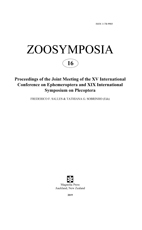Abstract
Thirty years after the first Ephemeroptera checklist (excluding Baetidae) of the Tafna basin (North-west Algeria) involved in an ecological study, new sampling investigations in 12 of the 48 sites prospected allowed us to record 12 taxa including six Baetidae taxa. The aim of the present study is to analyze and discuss the current diversity and distribution of Ephemeroptera. The results highlighted that more than half of the Ephemeroptera fauna previously mentioned has been depleted, with the loss of filtering and burrowing species. The mayfly fauna was mostly dominated by the family Baetidae (83%). Baetis (Rhodobaetis) sp. and Baetis pavidus were the most common taxa, with a large spatiotemporal distribution; other baetid species include Acentrella sinaica and Baetis maurus, two rheophilic species with strict ecological requirements and a distinct seasonality, as well as two limnophilic species Cloeon cf. dipterum and Procloeon stagnicola. Conductivity and habitat integrity seem the most influencing parameters to explain the current distribution and abundance of Ephemeroptera, especially Baetidae. Moreover, specific richness variability is related to conductivity and altitude.

